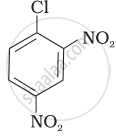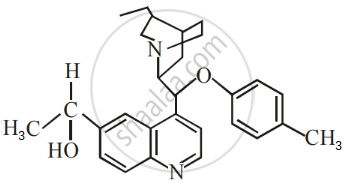Advertisements
Advertisements
प्रश्न
What is the action of the following on ethyl bromide:
silver acetate
Write the chemical reaction for the following:
Ethyl bromide is heated with silver acetate.
उत्तर
\[\ce{\underset{\text{ethyl bromide}}{C2H5Br} +\underset{\text{silver acetate}}{CH3COOAg}->CH3COOC2H5 + AgBr}\]
संबंधित प्रश्न
Write the major products(s) in the following:

How do you convert the following:
Ethanol to propanenitrile
Write the structure of the major product in each of the following reaction :

What are ambident nucleophiles? Explain with an example.
Which compound in the following pair will react faster in SN2 reaction with OH−?
(CH3)3CCl or CH3Cl
Write the structure of the major organic product in the following reaction:
\[\ce{CH3CH2CH2OH + SOCl2 ->}\]
Write the mechanism of the following reaction:
\[\ce{{n}BuBr + KCN ->[EtOH-H2O] {n}BuCN}\]
Arrange the compounds of the following set in order of reactivity towards SN2 displacement:
2-Bromo-2-methylbutane, 1-Bromopentane, 2-Bromopentane
Arrange the compounds of the following set in order of reactivity towards SN2 displacement:
1-Bromobutane, 1-Bromo-2, 2-dimethylpropane, 1-Bromo-2-methylbutane, 1-Bromo-3-methylbutane
What happens when ethyl chloride is treated with aqueous KOH?
How the following conversion can be carried out?
Ethyl chloride to propanoic acid
C–Cl bond length in chlorobenzene is shorter than C–Cl bond length in CH3–Cl.
SN1 reactions are accompanied by racemization in optically active alkyl halides.
Which would undergo SN2 reaction faster in the following pair and why ?
CH3 – CH2 – Br and CH3 – CH2 – I
What is the action of the following on ethyl bromide?
moist silver oxide
Which among MeX, RCH2X, R2CHX and R3CX is most reactive towards SN2 reaction?
Tertiary alkyl halides are practically inert to substitution by SN2 mechanism because of ____________.
The process of separation of a racemic modification into d and l-enantiomers is called ____________.
Which of the following is a chiral compound?
Which reagent will you use for the following reaction?
\[\ce{CH3CH2CH2CH3 -> CH3CH2CH2CH2Cl + CH3CH2CHClCH3}\]
How do polar solvents help in the first step in SN1 mechanism?
Aryl halides are extremely less reactive towards nucleophilic substitution. Predict and explain the order of reactivity of the following compounds towards nucleophilic substitution:
| (I) |  |
| (II) |  |
| (III) |  |
Why are aryl halides less reactive towards nucleophilic substitution reactions than alkyl halides? How can we enhance the reactivity of aryl halides?
In which reaction mechanism carbocation is formed?
The number of chiral carbons present in the molecule given below is ______.

The following questions are case-based questions. Read the passage carefully and answer the questions that follow:
|
Nucleophilic Substitution: Influences of solvent polarity: The reaction rate (SN2) of 2-bromopropane and NaOH in ethanol containing 40% water is twice slower than in absolute ethanol. Hence the level of solvent polarity has an influence on both SN1 and SN2 reactions but with different results. Generally speaking, a weak polar solvent is favourable for SN2 reaction, while a strong polar solvent is favourable for SN1. Generally speaking, the substitution reaction of tertiary haloalkane is based on SN1 mechanism in solvents with a strong polarity (for example ethanol containing water). |
Answer the following questions:
(a) Why racemisation occurs in SN1? (1)
(b) Why is ethanol less polar than water? (1)
(c) Which one of, the following in each pair is more reactive towards SN2 reaction? (2)
(i) CH3 – CH2 – I or CH3CH2 – Cl
(ii)

OR
(c) Arrange the following in the increasing order of their reactivity towards SN1 reactions: (2)
(i) 2-Bromo-2-methylbutane, 1-Bromo-pentane, 2-Bromo-pentane
(ii) 1-Bromo-3-methylbutane, 2-Bromo-2-methylbutane, 2-Bromo-3- methylbutane
An organic compound A with the molecular formula (+) C4H9Br undergoes hydrolysis to form (+) C4H9OH. Give the structure of A and write the mechanism of the reaction.
